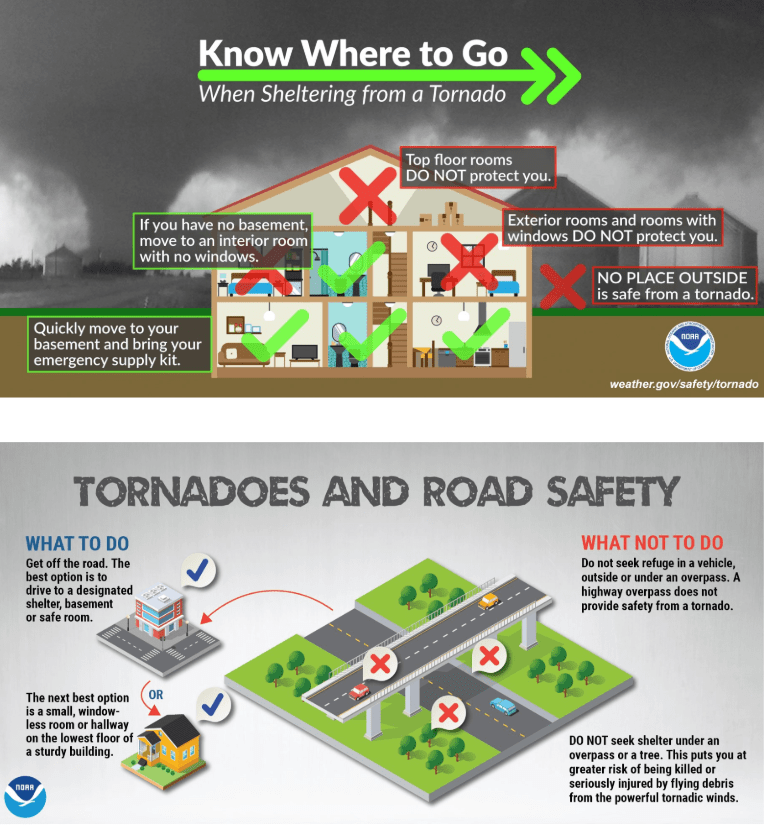Tornadoes are violent storms that don’t only strike in the traditional “Tornado Alley” region of the U.S. The southeastern part of the U.S. is starting to experience many more tornadoes over the past few years. Tornadoes can strike anywhere, including places like California, Arizona, Michigan, Pennsylvania, Virginia and New York.
Watch vs. Warning vs. Emergency
A Tornado Watch will be issued when conditions are favorable for severe thunderstorms to become tornadoes and thus you should stay alert and be prepared for changing conditions. A Tornado Warning means a tornado has been sighted or there’s a strong indication that one may develop at any time within the warning box area. A Tornado Emergency is the highest and rarest of warnings. A Tornado
Emergency means a tornado is in progress and will have significant impact to human life with catastrophic destruction to property.
What to Do
It’s critical you have a plan and that everyone knows what the plan is, whether it be at work or at home. What is the plan at work? What is the plan at home? Do your children know what to do if they are home alone? Make sure all of your communication devices are charged before the action is scheduled to begin in your area.
If you’re outside, get inside. It’s not time for photo shoots. There will be plenty others, including chasers, who will get that footage for you. Put on sturdy shoes and take blankets, helmets, and whatever else you can find to protect your head. Put as many barriers between you and the windows and the potential of flying debris as you can.
At Home
Head to the lowest floor. Being completely underground is best, but if that’s not possible, get to the lowest floor and towards the middle of the building. Smaller rooms are good. Stay away from doors, windows which may shatter, and outside walls which may collapse on you. Bathrooms that don’t have windows or outside walls are good because they are typically small and the plumbing adds some structural strength to the room. You can also choose to go under staircases, into closets (shut the door and cover up) and in hallways if you close the doors. In apartments, ground level clubhouses and laundry rooms often provide a good place to go if you live on upper floors. If you live in a mobile home, evacuate! Mobile homes can not stand up to even the smallest EF-1 tornado. It will get rolled over. For this reason, mobile home owners need to be extra vigilant of watches, and have a definite tornado plan ready to execute when needed.
Public Places
If you’re away from home, what do you do? In hotels and motels, review posted safety instructions along with fire exits when you check in. Hallways may be in the hotel’s plan for where to go in case of tornadoes, but make sure they don’t have doors and windows on either end. This makes them a wind tunnel for debris to fly through. Interior bathrooms and closets may be a better option.
In other public places like malls, stores, gas stations, and restaurants, stay inside and put as many walls between you and the outside as possible. Get to the lowest floor, get down and cover up with whatever you have to protect your head and body from flying debris. Don’t leave in your car! Sturdy buildings will protect you better.
Outdoor Activities—Campgrounds, Festivals, RV Parks, Sporting Events
Event planners should convey the plan for taking cover. This makes it all the more important for you to be weather aware! Before checking into an RV Park or campground, learn if there are storm shelters available and where they are located.
On the Road
Vehicles are amongst the last places you want to be in a tornado, so it’s critical you pay attention to weather conditions. If you can delay your trip, do so, but if not, make sure you monitor local radio stations or NOAA weather radio broadcasts, and know ahead of time where you are located. Weather warnings are issued by county, so know which counties you will be in. There are hundreds of weather apps that will track your location and send you alerts and notifications when you are in a watch or warning, even letting you know when lightning or heavy rain is near your area. The chances of being swept up in a tornado are much less than being affected by all the other severe weather that comes with them. Severe thunderstorms can produce large and damaging hail to break your windows, straight line winds that could topple you, and heavy rain to cause flash flooding which may sweep you off the road.
Stop and find a building to seek shelter in. If you’re stuck in traffic, you may need to seek shelter in a ditch, ravine or culvert as the last resort. Despite that very popular video which showed the TV reporter and the family who parked under an overpass and hid up under its girders as the tornado passed over, don’t ever do that! Powerful winds will kick up dangerous debris and send it flying up underneath the bridge like a wind tunnel.
